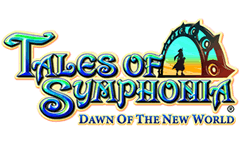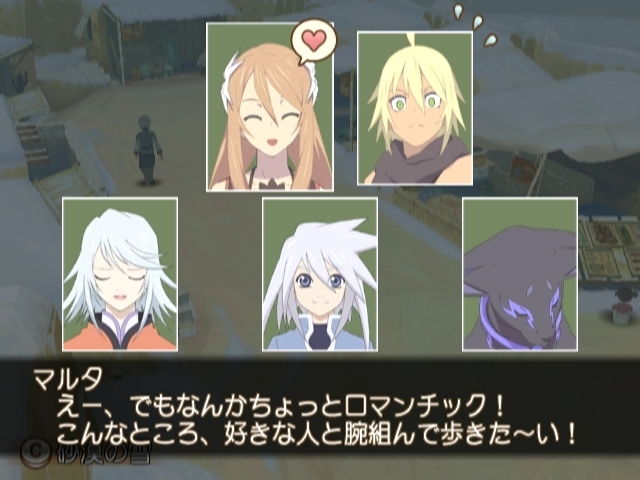|
|

|
PLATFORM
|
Wii
|
BATTLE SYSTEM
|

|
INTERACTION
|

|
ORIGINALITY
|

|
STORY
|

|
MUSIC & SOUND
|

|
VISUALS
|

|
CHALLENGE
|
Moderate
|
COMPLETION TIME
|
20-40 Hours
|
|
OVERALL

|
+ Terrific voice acting and dialogue.
+ Funnier than the first game.
+ Great battle system.
+ Memorable new characters with excellent interaction.
- Somewhat weak visuals.
- Most old characters have little to no new development.
|
Click here for scoring definitions
|
|
|
Namco-Bandai’s announcement that there would be a direct sequel to the ever popular Tales of Symphonia was met with both excitement and skepticism. Direct
sequels are not always known for their quality, and it did not help when it was revealed that the old characters were not the main focus of the game, there
would be no explorable world map, and there would be monster capturing and training. Being a huge fan of the first game, I I was hesitant about Dawn of the
New World. Eventually I decided to keep in mind that it is not the original and to enjoy it for what it was. Indeed I did enjoy for what it was--and then
some. I was pleasantly surprised by it and it managed to exceed my expectations. While the game has its shortcomings, it manages to live up to the first
game and I enjoyed it about as much as its predecessor.
Two years have passed since the first game ended and all is not well in the world of Tales of Symphonia. Despite the new Great Tree, the world is plagued by
unusual weather and climate patterns and powerful monsters. Furthermore, with the two worlds together again, the technologically advanced Tethe’allans look
down upon and oppress the Slyvaranti. This conflict erupts in an event known as the Blood Purge, a massacre by the Church of Martel allegedly led by the hero
Lloyd Irving. A boy named Emil Castagnier loses his parents in the massacre, hating Lloyd ever since. Months later Emil meets a girl named Marta Lualdi
who says that in order to return the climate to normal, the Summon Spirit of the old Kharlan Tree Ratatosk must be awakened. The timid adolescent joins
Marta, becoming a Knight of Ratatosk to protect her in her quest to awaken Ratatosk.
Like most Tales games, Dawn of the New World is reliant upon RPG clichés. Even if the plot is nothing new, the story itself is still well done. For the most
part the script is well-written with genuinely witty and funny dialogue. I was also impressed at how the story does not feel like a cheap cash-in on the
first game. The story is fairly well-developed, with one or two plot twists that are actually surprising. I found it to be a believable and welcome
continuation of the first game’s story.
 The Idiot Chosen battles alongside the new guys.
The Idiot Chosen battles alongside the new guys.
|
|
As with the original, though, the story’s strength more lies with its characters, character development, and interaction. Emil starts off as a cowardly,
quiet boy who can’t stand up for himself. As the game progresses, however, Emil slowly becomes more confident, braver and more willing to do what he must.
This is further enhanced by Johnny Yong Bosch’s excellent performance as he goes from being quiet and often stuttering to being more self-assured when s
peaking. In the meantime the contrast between him and the much more upbeat and love struck Marta make for some very amusing scenes and skits that easily
out-do those in the first game. Both she and Emil are fleshed out and well-developed, just as much if not more so than some of the characters in the first
game. Their romance is the best I’ve seen so far in a video game, not because of the character’s initial contrasting personalities, but how it develops over
the course of the game. Other new character such as Tenebrae the Centurion of Darkness, mysterious man Richter Abend and villains Alice and Decus are also
fairly rounded. In contrast to this, most of the returning characters have little to no development and apparently have not changed much in the two years
between games. This latter part may disappoint fans.
The Free-Range Linear Motion Battle System utilized in this game, as I understand it, is largely unchanged from previous incarnations. It’s relatively simple
system but quite fun, even with easier enemies. Unison Attacks return from Tales of Symphonia, but there is no combining of artes like Mirage Thrust and
Prism Stars. Instead, whichever battler matches the element on the grid, be it human/half-elf or monster, the former will attack the target while the latter
casts respective elemental spells. If there are multiple kinds of the same element on the grid, then a much stronger spell will be casted. The bosses in
this game can be quite brutal and have a lot of HP but the challenge is welcome. While it is possible to have up to four player controlled characters, it is
fairly uncommon to have four playable characters during the course of the game until much later as monsters cannot be directly controlled by players.
Luckily, the camera no longer focuses on Player 1 but pans out so that all player-controlled characters can be seen. It may also disappoint fans to know
that it’s not entirely clear on how to control the characters from the first game. While the second-to-fourth players can control them more easily, for a
single-player or player one, he or she has to switch to another character in the battle menu.
New to the Tales series is monster catching and raising. The aforementioned grid has one major element and four minor ones which can be seen on the lower
left side of the screen. By matching the major element to four minor elements, a monster can be captured provided it is the last monster beaten. Captured
monster join the party if there are empty slots and if not, are sent to the Katz guild. Aside from gaining levels, monster stats can be raised once per
level by giving it food that Emil, Marta, or any of the earlier characters cook. Feeding them is also how monsters can evolve into more powerful creatures,
which often branch off. They grow faster than the human characters, allowing them to become incredibly strong and can be quite useful during difficult boss
battles, especially since the original characters cannot level up or change equipment. Being a fan of the Pokémon games, I spent many hours capturing,
evolving and training creatures that I liked the appearance or power of, but those who do not like monster-battler games may not get as much enjoyment out of it.
The game runs smoothly for the most part, but loading screens can be a bit long, especially before a battle. Unlike the first Symphonia and most of the
Tales games released in North America, the skits are fully voiced. I chuckled at them often and found them funnier and overall better than the first game’s
skits. Being able to point at the screen and click A to use the Sorcerer’s Ring to be convenient. To rest assure those who loath Wii waggle controls, this
is the only point in towns and dungeon where motion control are used. On the overworld map it is possible to point to and choose locations, but it is usually
more convenient to pick the town or dungeon from a list. The only waggle controls during battles are for using some shortcuts, and sadly the remote isn’t
very precise in this. It is not always able to tell the difference between swinging the remote and nunchuck up-and-down or side-to-side, which resulted in
some annoyance and why I stuck to using the Control Pad shortcuts as much as possible. Other than that, I felt the controls were spot-on. I did find having
to hit the B button the button side of the remote awkward at first, but I quickly grew accustomed to it.
 Yeah, he's always flustered around her.
Yeah, he's always flustered around her.
|
|
The chibi-looking cel-shaded character of the old game is gone, replaced by anime-esque polygonal characters. Sometimes their movements are a bit stiff
during cutscenes, but mostly I enjoyed how realistic the movement can be. I also loved how expressive their faces are, from the more serious ones to the
goofy features such as eyes reduced to dots and other anime comedic effects. As good as the character models and designs are, however, the backgrounds are
lackluster and during cutscenes the background sometimes shimmers while the camera pans. I didn’t think the graphics were terrible, but they certainly could
have been better.
The music in Dawn of the New World is largely consisted of remixed version of the original game’s tracks. Each town has its old theme, the old characters
have their themes, and many battles will have “Full Force” or “Like a Glint of Light” depending on location. As with the first game, I thought the music
served the game well and was decent, but not particularly noteworthy save for a handful of outstanding tracks. I also would have liked it if there were more
original tracks since I found a few of them to be quite good, especially the new boss themes. It may be due to the skits, but this game feels like it has
much more voice acting than the first one. The acting itself is excellent, especially for Emil, Marta, and Tenebrae, who do most of the talking. That is not
to say there isn’t the occasional hiccup or poorly-done line, but these are easy to overlook. Fans may be upset to learn that many of the old character’s
voices have been replaced. Regal is no longer voiced by Crispin Freeman, Raine no longer by Kari Wahlgren, and others. Regardless, I thought they were still
good actors and many of them sound fairly similar to the original actors.
This game is clearly meant for fans of the first Tales of Symphonia. It tries to sum up the story from the first game, but most people who never played it
would probably not be able to get full enjoyment it. The game is by no means perfect and is certainly not as good as the first. However, considering that it
is a direct sequel, which tends to be rather sub-par, it is a pleasantly enjoyable game. The battle system is fun, the story compliments the first game
rather than feeling like an unnecessary tack-on, the new characters are well-developed and endearing, the voice acting is superb, and it is genuinely
funnier than the first. While the developers could have easily botched this game up, they put some real effort into Dawn of the New World which I greatly
appreciate.
Review Archives
|









